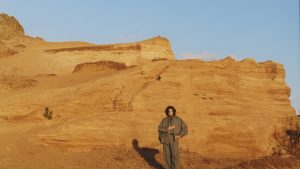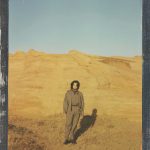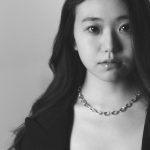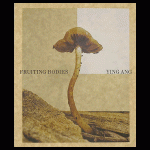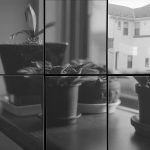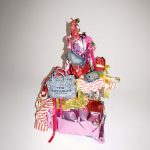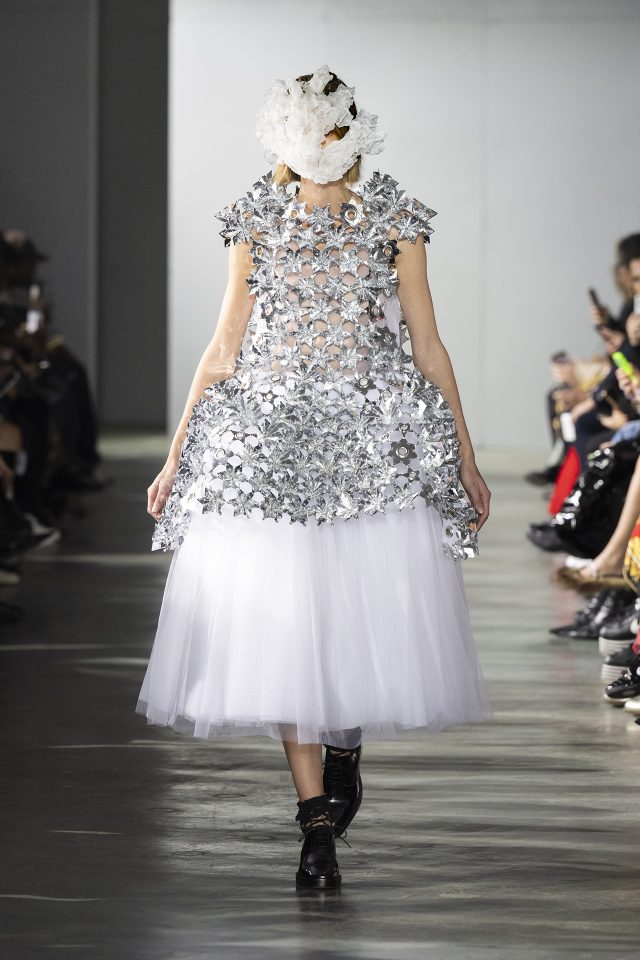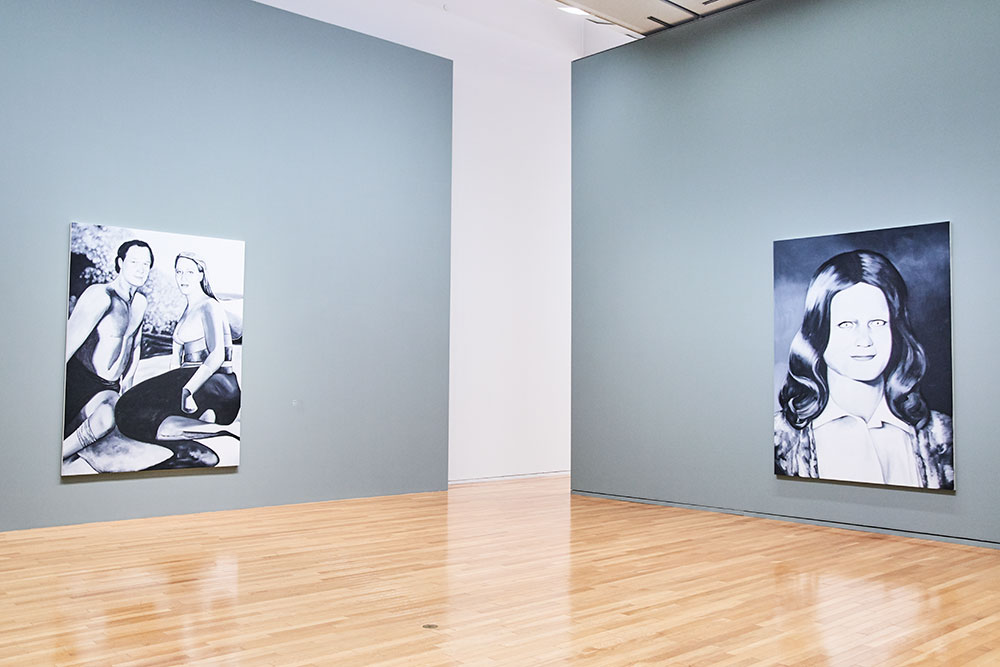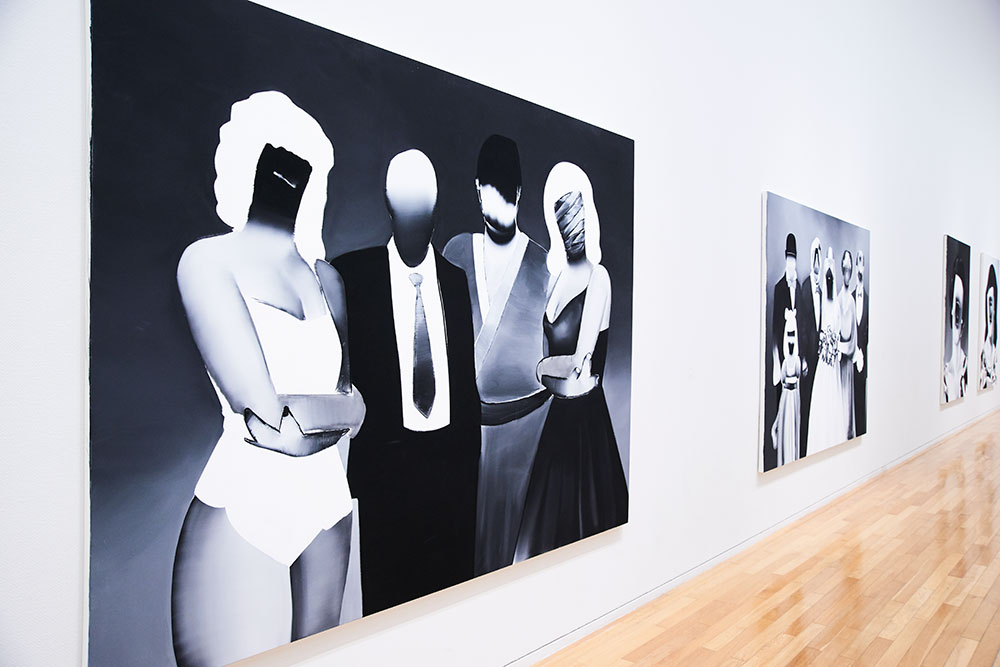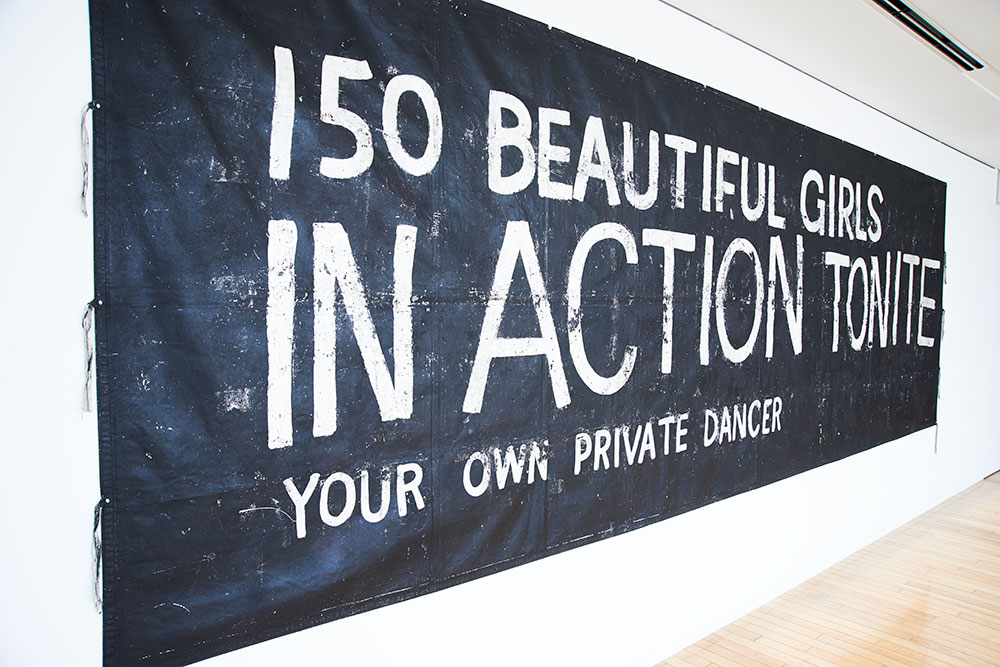画家・五木田智央インタビュー
Tomoo Gokita
Interviewer&Text: Madoka Hattori
Photographer: UTSUMI
個展を開けば、瞬く間に作品が完売する画家・五木田智央。イラストレーターやグラフィックデザイナーとしての経歴を忘れさせるほど、現代アート界はいま、五木田の作品に熱狂している。そのミニマルながらユーモアが見え隠れするモノクロームの世界は、ファッションデザイナーやミュージシャンにもファンが多い。4年ぶりとなる美術館での個展「PEEKABOO」。会場の東京オペラシティ アートギャラリーで話を訊いた。
画家・五木田智央インタビュー
Art
*You’ll find the English text after the Japanese.

Photo by UTSUMI | © Tomoo Gokita, courtesy of Taka Ishii Gallery
個展を開けば、瞬く間に作品が完売する画家・五木田智央。イラストレーターやグラフィックデザイナーとしての経歴を忘れさせるほど、現代アート界はいま、五木田の作品に熱狂している。そのミニマルながらユーモアが見え隠れするモノクロームの世界は、ファッションデザイナーやミュージシャンにもファンが多い。4年ぶりとなる美術館での個展「PEEKABOO」。会場の東京オペラシティ アートギャラリーで話を訊いた。
—2014年に千葉のDIC川村記念美術館で開催された個展「THE GREAT CIRCUS」から、約4年ぶりとなる展覧会ですよね。どれくらい前から準備されていたのですか?
オファーがあったのは去年ですね。ニューヨークのメアリー・ブーン・ギャラリーでの個展が2017年11月にあって、正式に決まったのはその後くらいでしょうか。ついこの間ですよ。4月にキュレーターの堀さんにお会いしたのですが、石井さん(五木田の作品を扱うタカ・イシイギャラリーのオーナー)から夏くらいに「都内の美術館で個展をやりたいんだけど」って言われて、「いいっすね〜」なんて軽く返事をしたら、あっという間に決まって。しかも、今年の1月に香港で個展を開催するって話も来たんです。オペラシティもあるのに無理じゃないのって思ったんだけど、石井さんに「香港で展示した作品を持って来ればいいよ」なんて言われてね。オレも流されるまま「なるほど〜」なんつって(笑)。気づけば休む暇もなく、ずっと描いていました。
—もっと前から準備されていたのかと思いました。半数以上が新作ですよね?
新作は16点のキャンバス作品と40点の額装した《Easy Mambo》シリーズです。実質、製作期間は1ヶ月半くらいかな。毎回やばいぞってなるんだけど、なんとか完成するんだよね。
—前半の旧作を含め、五木田さんはこんなに巨大な作品を作られていたのだと、改めて驚きました。
最初の部屋の作品は、海外で展示して既にコレクターに渡っていたものばかりだからね。生で見たことのある人ってすごく少ないと思います。なかなか国内でお披露目できる機会がなくって、今回の展覧会のおかげで借りられたんですよ。
—確かに、コレクターをみると、ZOZOTOWN の前澤友作さんに、アーティストの KAWS、ミュージシャンのテイ・トウワさんといったそうそうたる顔ぶれですよね。
とにかく空間の大きい美術館で個展を開くなら、旧作がどれだけ借りられるかが勝負だなと思っていて。実は、DIC川村記念美術館では、かなり苦労したんです。でも、今回は希望した作品すべてに貸出しOKがでて、これはイケるなと。ちなみに、香港で展示したものは2点《Holiday Flight》《Please Be Kind》だけ持ってきました。ほかにも色々借りられそうだったのですが、自分なりの展示に向けたハードルがあって、そこをクリアしたのがこの2点だったんです。
—では今回は、かなり五木田さんのディレクションが入った展覧会ということですね。
そう、やりたい放題でしたよ。レコードのアルバムジャケットの作品《Gokita Records》は絶対NGがでるだろうって思っていたんだけど、すんなりいいよって。裏テーマは「美術館を中古レコード屋にしてやる」だから(笑)。2002年から16年間、いまも作っているシリーズで、一度、高円寺の『LOS APSON?』というレコード屋さんで展覧会をやったんですけど、ついに美術館にまとめて展示したという。痛快ですね。
—なるほど、五木田さんなりのホワイトキューブに対するアンチテーゼ的な?
いや、照れですね(笑)。100パーセント格好つけたことってできなくて。なにかしらギャグを混ぜたいんです。で、最後に落とそうと。

Photo by UTSUMI | © Tomoo Gokita, courtesy of Taka Ishii Gallery
—タイトルの「PEEKABOO」は “いないいないばあ”という意味ですが、何か仕掛けがあるのでしょうか?
ないですよ、本当に意味なんてない。こういう展覧会って、先にタイトルを決めなきゃいけないんですよ。1枚も描いて無いのにさ、無理でしょう(笑)。それで、気になる単語をバーっと120個くらい書きだして、抽象的な、なるべく意味をもたない言葉を選びました。それだけです。
—わざわざ意味を探ろうとするなんて野暮な質問だとは思っているのですが、どうしても知りたいんですよね。絵画を観れば言葉なんて必要ない。とはいえ、カタログに収録されているキュレーターの堀さんのテキストにはゲルハルト・リヒターのモノクローム作品《グレイ・ペインティング》との比較について語られています。モノクロームへのこだわりは、より強くなっているのでしょうか?
モノクロだけでいきますと言っているわけではないんですよ。展覧会が立て続けに決まっていて、新しい実験が追い付いていないだけ。9月にはロサンゼルスでの個展もあるんでね。だから実験するよりも、いまのスタイルを極めている段階です。とはいえ、新たな発見もあって。昔は、看板絵のようなチープでツルッとしたタッチをあえてやっていたのですが、最近は止めていて。わりと筆跡が残るようにしているんです。
—確かに後半の新作は、ぽってりと絵の具がのった部分がある一方、キャンバスが透けるほど薄塗りの部分があったりと、絵画を生で観る楽しさを教えてくれます。
どうしてもオレの癖で、きれいに仕上げすぎちゃうんですよ。ついつい描き込んじゃうのを、寸止めして、あえてマチエールを残すのがいまは気持ちよくって。そこに快楽がグッとくる。モノクロの作品が続いているけど、実は細かい変化がいっぱい起きているんです。あと、使う筆も総取っ替えしたんですよ。昔使っていた豚毛の筆がたまたま出てきて、使ってみたら「あ!コレだ!」って。すぐに今まで使っていた筆をやめて、新しく買い揃えました。
—それは新たな色を使うのと同じくらいの大きな変化では?
そう、描き方も変わっちゃったからね。筆跡を残すのも、豚毛のほうが合っていて。安い筆なんですけどね。あとは、去年のメアリー・ブーン・ギャラリーの個展で《FAKE CEZANNE》シリーズというのをやったんです。「オレ空っぽになっちゃったな」「描くモノがないな……」って絵画に行き詰まった時に、たまたまセザンヌの画集があってパラパラ観ていたんです。「なんで林檎なんか描いてるんだろ」と思い、ふと真似してみたらすごく面白かった。最初は単に模写をしていただけなんですけど、段々、見なくてもセザンヌ的な絵が描けるようになってしまい……(笑)。メアリーは絶対嫌がりそうだなって思ったんですけど、出したら意外と評判よかったんだよね。
—アートの文脈を再解釈したというか、すごくコンセプチュアルな作品に捉えられたのでしょうか。
どうかな。いい深読みをされちゃった感じはあるね。でももうやらない。そういう手法で作品を作る人はいっぱいいるじゃない。単純に行き詰まっていただけだから(笑)。つたない英語で説明したから、伝わっていたかわからないけれど。
—五木田さんの経歴は異色で、イラストレーターからスタートしていますが、いまや完全に現代アートのマーケットの中に入っていますよね。サブカルチャーをモチーフにすると批判されたりすることもありますが、現代アートの場での感触はどうですか?
未だに言われますよ「お前の作品はイラストじゃん」て。「うるせーな」って思うけど、言わせておけばいい。海外にでたら全く関係ないから。逆にグラフィックデザインをやっていたってことにビックリされるくらい。日本は勝手に上下関係に置き換えて考えて、イラストレーターを軽くみるんだよね。それにもムカつくしさ。イラストレーターがどれだけ大変な仕事かわかってねーなって。でも今は、画家としか言いようがない。自分は“画家”なんだってね。芸術家とかアーティストとも言いたくないんだよ。
—アーティストというと絵画だけではなく、映像や彫刻作品などメディアは多岐にわたりますよね。シンプルに絵を描いているというところで画家だと言い切りたい気持ちはわかります。
粘土とか、遊びで立体も作ったりするんだけどね。でも作品としては絵画だけ。やってみたいなとは思うけど。設計図だけ描いて、アシスタントや業者に発注するやり方もあるけれど、好きじゃないんだよね。単純に「自分で描きなよ」って思う(笑)。
—Tシャツやレコードジャケットのアートワークなども制作されることが多いかと思うのですが、キャンバスに描くこととどう違いますか?
完全に違うチャンネルですね。今回もTシャツをつくったんだけど、キャンバスの作品を単にTシャツにプリントするのはあまり好きではなくて、TシャツはTシャツ用に着た時の格好良さでデザインしたい。グラフィックデザイナー時代の燃えカスがまだ残っていて、そこは全く別の話で。絵画ではできないことをやらせてもらっている感じです。
—とはいえ、絵画作品のサイズ感は日本の住環境では追いつけないレベルに達していますよね。
作品をスタジオから出す時も大変でね。大きなスタジオならシャッターだと思うんだけど、ウチは工場の跡地を改装しただけだから。200号(2,590mm ×1,940mm)の作品は、引き戸を2枚外して斜めにしながら窓から搬出しているんですよ。本当は300号とか描きたいんだけど、絶対出せないから(笑)。
—流されるままと言いながらも、現代アートのど真ん中に来たからには、これからは自覚的にならないとやっていけないのではと思うのですが。今後の展望は?
大変ですよ、ほんと。来年50歳ですから。キャンバスを貼る作業が辛くってね……。今回はギャラリーのスタッフに手伝ってもらって何とか間に合いました。描くのは3時間くらいでイケるんですけど、展覧会が続くと時間がいくらあっても足りなくって。でも、全然まだまだなんで。もっと頑張りたいですね。
<プロフィール>
五木田智央(ごきた・ともお)
1969年東京生まれ。イラストレーションから出発し、60〜70年代のアメリカのサブカルチャーやアンダーグラウンドに影響を受け、当時の雑誌や写真にインスピレーションを得た作品を発表。90年代後半にドローイング作品により熱狂的な支持を得る。その後、キャンバスにアクリルグワッシュで描くモノクロームの人物画を中心に制作。ニューヨーク、ロサンゼルス、ベルリンなどでも作品を発表し、高い評価を受けている。2014年に佐倉市のDIC川村記念美術館で個展「THE GREAT CIRCUS」を開催。また、出版物も多く、作品集に『ランジェリー・レスリング』(2000年)、『シャッフル鉄道唱歌』(2010年)、『777』(2015年)、『Holy Cow』(2017年)などがある。
| 展覧会情報 | |
| タイトル | 五木田智央 PEEKABOO |
| 英題 | Tomoo Gokita : PEEKABOO |
| 期間 | 2018年4月14日 (土)〜6月24日 (日) |
| 会場 | 東京オペラシティ アートギャラリー |
| 住所 |
東京都新宿区西新宿3-20-2 3F |
| 開館時間 | 11:00〜19:00(金・土は11:00〜20:00/いずれも最終入場は閉館30分前まで) |
| 休館日 | 月曜日 (ただし4月30日は開館) |
| 入場料 | 一般 1,200円(1,000円)、大学・高校生 800円(600円)、中学生以下無料 |
| HP | http://www.operacity.jp/ag/exh208/ |
Painter, Tomoo Gokita’s work sells out as soon as he has his own solo show. Because everyone in the modern art world is enamored with his work, it’s easy to forget that he comes from an illustration and graphic design background. His minimal yet humorous monochromatic work mainly attracts fashion designers and musicians. ‘Peekaboo’ is his first museum exhibition in four years. We spoke to him at the venue, Tokyo Opera City Art Gallery.
—It’s been four years since your solo show, ‘The Great Circus,’ which was held at Kawamura Memorial DIC Museum of Art in Chiba. How long did it take for you to prepare for your current exhibition?
I got an offer last year. I had a solo show at Mary Boone Gallery in New York last November and I started getting ready for this show around the time that had ended. That was so recent. I met Hori, who’s a curator, in April and Ishii (the owner of Taka Ishii Gallery who handles Gokita’s work) said that he wanted to have a show in a museum around summertime. I lightheartedly said ‘sounds good’ and before you know it, the decision was already made. I also was asked to have a solo show in Hong Kong this January. I thought it was going to be impossible because of this current show at Opera City but Ishii told me that I should just bring the work I exhibit in Hong Kong. I went along and said ‘I see, I see’ (laughs). When I realized, I was drawing all day long.
—I presumed that you had been preparing even before that. More than half of the work here are new right?
I have 16 new canvas paintings and 40 new framed pictures, which is a series called ‘Easy Mambo.’ Honestly, it took about a month and a half to come up with these. I always think I’m in deep trouble but I somehow manage to get the work done.
—I was surprised by how you could make such grand things, including both your new and old work.
The first set of art you see were in the hands of collectors abroad. I think only a few people have seen them in real life. It’s very rare to be able to see these within the country so it was thanks to this show that we were able to bring them over.
—Amongst those who collect your work are Yusaku Maezawa of Zozotown, artist Kaws, and musician Tei Towa. You have prominent figures as collectors.
I thought it was a matter of just how many of my old work I would be able to borrow since I was given the opportunity to have a solo show at a big art museum. To be honest, it was tough preparing for my exhibition at Kawamura Memorial DIC Museum of Art in Chiba. However, for this one I was able to borrow everything I wanted so I thought I had a shot. By the way, I only brought two pieces from my show in Hong Kong: ‘Holiday Fight’ and ‘Please Be Kind.’ It seemed like I could’ve borrowed more but I had this standard I had set up for myself and I felt as though these two were the only ones that met the criteria.
—So you really directed this current show of yours.
Yeah, I could do whatever I wanted! I thought the record cover piece, ‘Gokita Records’ would be turned down but they said yes right away. The alternative theme was ‘I’m going to change this art museum into a second-hand record shop’ (laughs). This series is something I’ve been working on for sixteen years, since 2002. I had a show at this record store in Koenji called ‘Los Apson?’ and that was recently made into a show at an art museum. It was quite delightful, I must say.
—I see. Is this your personal form of rebellion against the white cube?
Aw shucks (laughs). I can’t do something that’s 100% cool. I always want to mix some humor in there. And so, I thought ‘this’ll do it.’
—You use the word ‘peekaboo,’ which is the title of your show, when you play hide and seek but is there some sort of trap here?
Nope, there really is no meaning. For these kinds of exhibitions, you need to come up with the title first. It’s impossible to do that when you haven’t even finished a single piece (laughs). I wrote about 120 words that I liked and I chose words that were abstract and didn’t have a lot of meaning to it. That’s all.
—I don’t want to throw a wet blanket on it by searching for a deeper meaning but I really want to know the answer. When you look at a painting, you don’t need words. Regardless, your work is compared to Gerhard Richter’s monochromatic pieces, ‘Grey Paintings’ in Curator Hori’s catalog. Has your preference in regards to monochrome become stronger?
It’s not like I’m set on only making monochromatic pieces. It’s just that I have a lot of shows lined up and don’t have enough time to experiment more. I have another show in Los Angeles this September. So I’m at this stage where I stick to my current style rather than playing with other styles. Having said that, I have made some new discoveries. I used to have that shiny finish billboards have but I’ve quit doing that recently. I now try to leave my handwriting as it is.
—On one hand, your later work have this plump spots of paint whilst on the other hand, some parts are covered with very light paint. It teaches us to enjoy looking at paintings in the flesh.
An old habit of mine is to finish something up way too nicely. Now, it feels nice to stop myself from polishing it up too much and leave this amateur-ish touch to it. There’s a lot of pleasure in doing that. Sure, I have a lot of monochromatic pieces but there are a lot of small changes. I also changed the brush. I used to use this brush made out of pig hair which I coincidentally found out of nowhere. When I used it, I knew it was the one. I quit using the brush I was using at the time, and bought new ones.
—Was that change as big as using a new color?
Yes, the way I draw has also changed. It’s better to use a pig hair brush if you want to leave your handwriting. It’s a cheap brush though. Also, I had this series called ‘Fake Cezanne’ exhibited at Mary Boone Gallery last year. I felt as though my work had become empty and I felt as though I had nothing to draw. Just when I was stuck in a rut, I saw a collection of Cezanne’s drawings and I flipped through them. I thought, ‘why is this person drawing apples?’ and when I tried it, it was actually really fun. I copied it at first but eventually, I became able to draw in a Cezanne-esque way without looking at the source (laughs). I thought Mary was going to hate it but when I showed it to her, she actually liked it.
—I feel like perhaps it turned out to be a very conceptual piece of work, because you re-interpreted art in a different context.
I don’t know. It feels like people read into it too much. I won’t do it again. There are plenty of people that make artwork like that. I was just at my wit’s end (laughs). I explained it in broken English so I’m not sure if my message went through.
—You started your career as an illustrator that used color but now, you’re knee deep in the modern art market. I reckon you get judged, as you use subcultures as a motif but how does it feel to be in the realm of modern art?
People still do say that to me: ‘you just make illustrations.’ It makes me think, ‘shut up’ but I let them say what they want to say. Once you’ve made it abroad, none of that matters. People are more surprised when they find out that I used to do graphic design. People in Japan think in arbitrary hierarchies and illustrators are seen as unimportant. That makes me angry too. It makes me realize that they don’t know how tough it is to be an illustrator. But the only way you can describe me now is as a painter. I’m a ‘painter.’ I don’t want to call myself an artist.
—The word artist encompasses a wide variety of mediums such as film and sculpture, rather than just paintings. I do understand how you want to simply state that what you do is paint, thus calling yourself a painter.
I do make three-dimensional things out of clay and such for fun. But I put out my paintings as my work. I would like to try other things though. I can make the blueprint and have assistants and craftsmen do it but I don’t like that method. It makes me think, ‘do that yourself then’ (laughs).
—I’m sure you work on t-shirts and record covers a lot as well but what’s the difference between that kind of work and drawing on a canvas?
They’re completely different mediums. I made t-shirts this time too but I don’t like printing out a canvas piece onto a shirt. I want to design shirts that are cool when you wear them. I still have that fire from my graphic design days left in me. That’s a completely different story. It’s like I get to do something I can’t with paintings.
—The size of Japanese living spaces are incompatible with the size of your work, right?
It’s tough to even get my pieces out of the studio. Big studios have shutters but my studio is an ex-abandoned factory that was revamped. To get 2,590mm x 1,940 mm pieces out of the studio, we need to take out two sliding doors, tilt the piece, and then carry it out from the window. I want to make pieces that are one size bigger but we’ll never be able to get them out (laughs).
—You mentioned how you went with the flow but you’re right in the center of modern art. I reckon you have to make art with even more self-awareness. What’s in the future for you?
It’s tough, really. I’m 50 next year. Putting canvases up… now, that’s tough. The gallery staff helped me out so I made it on time. I can whip something up in three hours but when you have shows lined up one after the other, you just don’t have enough time. But, I still have lots more to give. I want to work even harder.
<Profile>
Tomoo Gokita
Tomoo Gokita was born in 1969 in Tokyo. He gained attention in the late 90’s for his extemporarily produced drawing works. In recent years he has created abstract paintings that simultaneously pay heed to specific motifs, including portraits which appropriate the colors of black and white. As well as being involved in a vast number of publication activities and exhibitions within Japan, he has participated in solo and group exhibitions in New York, Los Angeles, and Berlin; continuing to receive high international acclaim. Taka Ishii Gallery presented solo exhibition with Gokita in 2008, 2012 and 2017. In 2012 he participated in the group exhibition, “The Unseen Relationship: Form and Abstraction” at the Kawamura Memorial DIC Museum of Art. Publications include LINGERIE WRESTLING, (Little More Co.Ltd., 2000)
